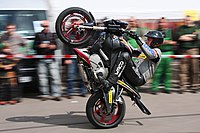
Photo from wikipedia
Two-degree-of-freedom (2-DOF) pointing mechanisms, including the gimbal structure, the 1-RR&2-RRR spherical parallel mechanism and the Omni-wrist III are increasingly applied in tracking devices, mechanical transmission and artificial joint. Though they… Click to show full abstract
Two-degree-of-freedom (2-DOF) pointing mechanisms, including the gimbal structure, the 1-RR&2-RRR spherical parallel mechanism and the Omni-wrist III are increasingly applied in tracking devices, mechanical transmission and artificial joint. Though they share the same number of degree-of-freedom at any given configuration, they will exhibit and transfer different motion characteristics, such as rotation and rolling, when moving continuously. Thanks to the concept of operation mode, these three mechanisms’ distinct continuous motion characteristics can be identified and further compared through Euler parameter quaternions, Euler-angles, algebraic geometry and axodes so that the appropriate mechanism for tracking or transmission can be selected. At first, elementary operation modes are numerated based on the number of zero components in a quaternion. In order to acquire all possible operation modes, a set of constraint equations relating to each mechanism are formulated, and an algebraic geometry method is adopted to solve the constraint equations that are much too complicated. For rotation, namely 1-DOF operation mode, its continuous rotation axes are investigated. As to rolling, namely 2-DOF operation mode, allowing for the fact that the difference in 2-DOF operation mode of the three mechanisms is not intuitive, axode characteristics of the three mechanisms are investigated and compared. It is found that from the above process of identification and comparison on rotation and rolling, the three mechanisms’ distinctive motion characteristics can be effectively obtained.
Journal Title: Journal of Mechanisms and Robotics
Year Published: 2017
Link to full text (if available)
Share on Social Media: Sign Up to like & get
recommendations!